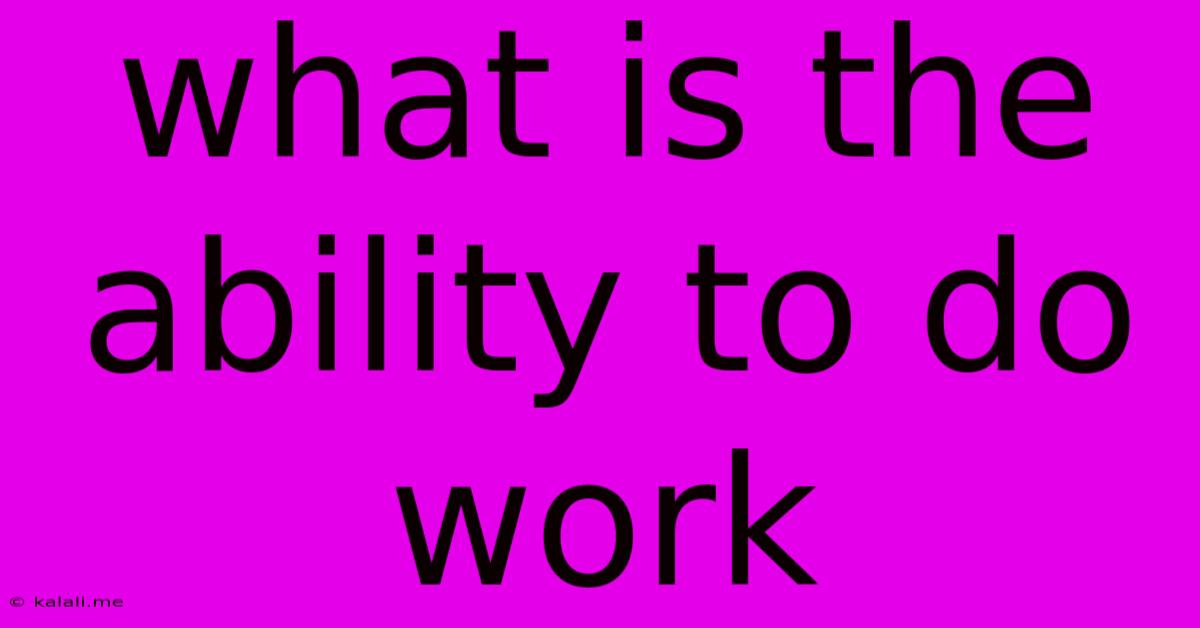What Is The Ability To Do Work
Kalali
Jun 01, 2025 · 3 min read

Table of Contents
What is the Ability to Do Work? Understanding Energy and Its Forms
The ability to do work is fundamentally defined as energy. This isn't just about physical labor; it encompasses any process that can cause a change in a system. Understanding energy is crucial across many scientific disciplines, from physics and chemistry to biology and engineering. This article will explore the concept of energy, its various forms, and how it relates to the capacity to perform work.
What is Work?
Before delving into energy, let's clarify what "work" means in a scientific context. In physics, work is done when a force causes an object to move a certain distance in the direction of the force. This means simply applying force isn't enough; the object must actually move. For instance, pushing against a wall exerts force, but no work is done because the wall doesn't move.
Energy: The Capacity for Work
Energy is the capacity of a system to do work. It's a conserved quantity, meaning it can neither be created nor destroyed, only transformed from one form to another. This principle is known as the law of conservation of energy. This transformation is key to understanding how energy fuels various processes in the universe.
Different Forms of Energy:
Energy manifests itself in numerous forms, including:
-
Kinetic Energy: The energy of motion. Anything that is moving possesses kinetic energy, from a rolling ball to a speeding car. The faster the object moves, the greater its kinetic energy.
-
Potential Energy: Stored energy that has the potential to be converted into kinetic energy. Examples include:
- Gravitational Potential Energy: Energy stored due to an object's position in a gravitational field. A book held high above the ground has gravitational potential energy.
- Elastic Potential Energy: Energy stored in a stretched or compressed object, like a stretched rubber band or a compressed spring.
- Chemical Potential Energy: Energy stored in the chemical bonds of molecules. This is the energy released when we burn fuel or digest food.
-
Thermal Energy (Heat): The total kinetic energy of the particles within a substance. Higher temperatures correspond to greater thermal energy.
-
Radiant Energy (Light): Electromagnetic radiation, including visible light, ultraviolet light, and infrared radiation. Sunlight is a prime example.
-
Nuclear Energy: Energy stored within the nucleus of an atom. This is released through nuclear fission (splitting atoms) or nuclear fusion (combining atoms).
-
Electrical Energy: Energy associated with the flow of electric charge. This powers our homes and devices.
-
Sound Energy: Energy transmitted through vibrations.
Energy Transformation and Transfer:
Energy constantly transforms and transfers between its various forms. For example, a hydroelectric dam converts gravitational potential energy (water held high behind the dam) into kinetic energy (moving water) and then into electrical energy (through a generator). This highlights the interconnectedness of different energy forms and their ability to perform work.
Conclusion:
The ability to do work is synonymous with energy. Understanding the various forms of energy and their transformations is fundamental to comprehending the workings of the universe and the technological advancements that rely on harnessing and converting energy. From the simple act of lifting an object to the complex processes powering modern society, energy is the driving force behind it all. Further exploration into thermodynamics and energy efficiency will provide a more nuanced understanding of this vital concept.
Latest Posts
Latest Posts
-
Mac Os 13 4 Mail Prevent Mail Form Loading Automatically
Jun 02, 2025
-
Question That Cant Possibly Be Answered No
Jun 02, 2025
-
Hope This Email Finds You Well Meaning
Jun 02, 2025
-
Where Did The Term Christian Come From
Jun 02, 2025
-
Only Merging Features May Be Patterned
Jun 02, 2025
Related Post
Thank you for visiting our website which covers about What Is The Ability To Do Work . We hope the information provided has been useful to you. Feel free to contact us if you have any questions or need further assistance. See you next time and don't miss to bookmark.